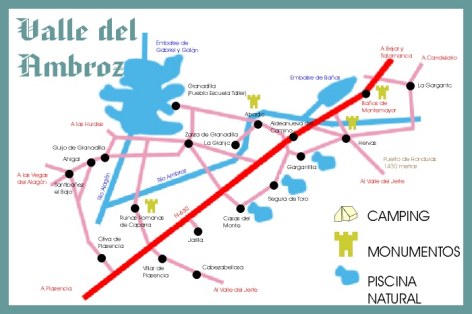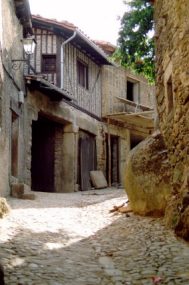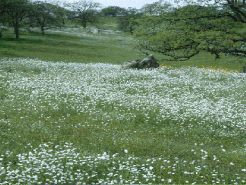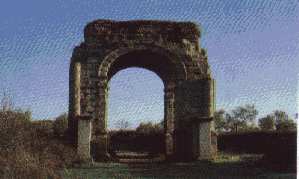
MAKE CLICK ON THE TOWN OF WHICH IT WANTS INFORMATION IN THE INTERACTIVE PLANE.
Located in " the Route of the
Silver " between the cities of Béjar and Plasencia, is step
forced between Castilla and Extremadura. It takes his name from
natural attractive the great river that crosses it and offers to
the visitor, product of his resisted geography.
Their forests and meadows that during great part of the year are conserved green are one of their great tourist attractions. The climate is another one, his invier temperings to us and smooth summers allow to a hortofrutícola production of excellent importance, together with the great amount of water coming from the snow-covered summits that surround the valley and furrows streams, torrents, marshes, and springs.
Abadía
Convent of the Stopped Good and Palace of Soto Fermoso.
Aldeanueva del Camino
Fruit of the union of two villages uinficadas in S. XIX is their two Churches, the one of San Servando of the S. XVI and the one of our Lady of the Elm tree of S. XV and S. XVI.
Baños of Montemayor
Church of Santa Maria (S.XVI and XVII); Thermal Station (Bath).
Cabezabellosa
Within this town it is elevated a Church of centuries XVI and XVII and hermitages barrocas of centuries XVII and XVIII.
Cáparra
They are the Rest of a Roman City called Cáparra (Centuries I and II) where at the moment are continued doing studies and excavations of his theater and basilica. Tetrapilón has Arco, famous contrucción that characterizes to this legendary city.
Casas del Monte
With the Church of san Mateo and one old Roman road.
Hervás
In this beautiful town it emphasizes the Jewish District, the Church of Santa Maria (S.XIV and XVII), Church of San Juan Baptist, the City hall (S.XVII), the Palace of the Dávila, (it lodges the Museum Perez Commander), the Bridge Chiquita Source on the Ambroz river. (the monument of the oldest city),
Gargantilla
In that the Perché District emphasizes on all its places of interest, along with a Church under the invocation of the Santiago Apostle.
Granadilla
Town founded by the Muslims on left and recovered S. IX. Rest of monumental monuments can nowadays be seen.
Guijo de Granadilla
Here it lived and it died in 1905 the poet Gabriel and Galán. For that reason is a museum of the famous writer Jose there Maria Gabrien and Galán. The house of this poet can be visited.
 Jarilla
Jarilla
It has the Church of San Gregorio, declared artistic monument and a Roman temple.
La Garganta
Located to more than 1000 meters of height, it can be observed impressive landscapes. In the town it emphasizes the Church of the Asunción of S. XVII and XVIII.
LA Granja
Parochial church of Sta. Maria Magdalena of S. XVI and in its nterior an altarpiece of baroque style.
Oliva de Plasencia
The Palace of the Olive Counts, S. XVII and the Parish of San Blas of S. XVI where it emphasizes an altarpiece of S. XVIII and Baroque style.
Segura de Toro
Surely of origenes celtas, this villa, in its Greater Seat rises the Church of San Juan of S. XV. The rest of a Tower of a Castle of S. XIII serve like bell tower of the Church.
Villar de Plasencia
Between its constructions we have the Church of Asunción, of S. XVI, the Hermitage of San Bartholomew and the one of san Antonio de Padua.
Zarza de Granadilla
Church of San Ramon and Hermitage of the Christ.

CITY COUNCILS:
Abbey. 48 42 52
Aldeanueva of the Way. 48 40 48
Baths of Montemayor. 42 80 12
Cabezabellosa.48
90 41
Houses of Monte.17
90 23
Gargantilla.48
41 38
The Farm. 48
61 61
Guijo de Granadilla. 43 90 82
Hervás. 48
10 02
Jarilla. 48
90 86
Olive of Plasencia. 45 47 57
Safe of Toro. 48
41 57
Villar de Plasencia. 48 90 14
Bramble of Granadilla. 48 60 04